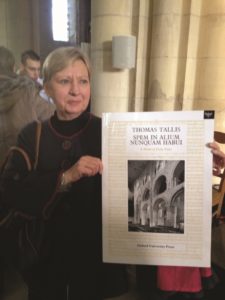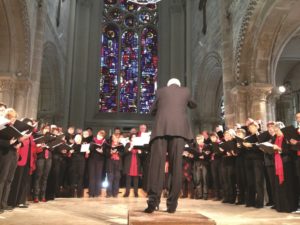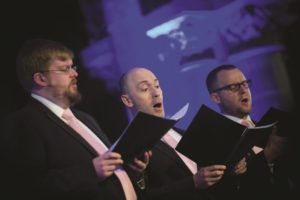Polyfollia 2012
Francesco Leonardi
IFCM Project Manager and Artistic Director of Associazione Jubilate
The fifth Polyfollia festival took place inside the walls of the Norman town of Saint-Lô. It is a biennial event has the region’s churches and theatres ringing with majestic vocal music. The unique structure of the festival is based around the four core principles of choral music: that it is for amateurs, professionals, for recreation and teaching. Polyfollia is the crossroads to all of these and fertile ground for starting new collaborations and artistic journeys.

A typical day, for someone who does not want to miss a thing, starts at nine in the morning with a choice of participatory workshops, American or Asian music, meetings with the choirs and composers and much more. I chose to go to see how a piece of music for 40 voices is put together. Under Peter Broadbent’s direction, a group of almost 100 amateur singers, with a couple of prominent ‘intruders’, sang Tallis’ motet Spem in Alium. After about two and a half hours to practice (the choir had the score in advance in order to study it), they put on a concert in front of a big crowd made up of both professionals and interested spectators. Everyone enjoyed the workshop: members of the choir – who had sung a remarkably tricky piece of music – and also the audience, which called for a full encore.

After the morning singing, a well-earned break to refuel was required. In the building, which also functions as a restaurant, more than a thousand choral music lovers sat down together. Both professionals and amateurs mingled, sharing a desire to get to know each other and to talk about music. This led to a continuous exchange of ideas, questions, photos and even some autographs.

We then migrated towards the centre of town and chose our next workshop or round table. I attended a meeting reserved for professionals, on the diffusion of choral music on radio. George Laverock, a Canadian broadcaster of some standing, moderated the event, along with representatives from the most important radio stations in the world. There was an hour of talk on the global situation and possible future scenarios. Despite the difficulties in the recorded music market, radio remains an important medium for the diffusion of choral music, and programmes dedicated to it are still very popular, even if not always over the ether but rather over the Internet.

In the Notre-Dame Church amateur choirs from all over France were singing in the ‘Chaînes Chantantes’ event. Venues were in close proximity to each other and I had time to pop in to the cultural centre, where I was able to leaf through Sulasol and Annie Bank Edition scores. By now my bag was full of CDs by visiting choirs and interesting brochures on festivals and ensembles from all over.
I arrived shamefully late for the start of ‘Chaînes Chantantes’, so-called because each choir is on stage with a repertoire of fifteen minutes each, like a chain. The choirs were all amateur groups from all over France even though there is no ban on foreign choirs. The level of performance varies but the desire to make music is evident, as is the wish to be part of such an important, international event.
But it was already time to go back to the restaurant, full of questions and anxious to have dinner with colleagues and friends but also with the CAMP people (Choral Art Management Program), young managers who have come to Polyfollia to learn how to export the festival model and adapt it for their own countries. After dinner it was time for the gala concert in the Salle Beaufils, as always packed to the rafters, and where on this occasion I heard three of the professional choirs chosen for the festival, with forty-five minutes of repertoire each. The decision process of the choir selection is interesting in its own right: seven leading names in choral music worldwide put forward choirs, based on their geographical location, then the artistic commission decides on the appropriate mix of styles, formation and repertoire. This year the twelve choirs invited were: New York Polyphony (USA), Taipei Chamber Singers, Svanholm Singers (Sweden), Kyn (Finland), Cadence (Canada), Audiofeels (Poland), Discantus (Hungary), The Gents (The Netherlands), Conspirare (USA), Dá no Coro (Brazil), Philippine Madrigal Singers, and Pust (Norway). There were also Leioa Kantika Korala from Spain and Young People’s Chorus of NYC, two talented youth choirs which represent important educational projects.

Every day there is an extensive and varied calendar of events; every day is busy and perhaps long too, but always with choral music as the focus. Polyfollia is a total immersion in the world of song and never gets tiring. Of course, not everyone has to do it this way; you can have some time out and take a tour to nearby Mont Saint-Michel or to the D-Day beaches, perhaps returning in time for the evening concert.

For professionals, Polyfollia is a much awaited date in the diary, with an entire day dedicated to them: ‘Professionals Day’ gives over 300 international guests the opportunity to make new contacts and plan new collaborations. The festival is an important showcase that can lead to numerous bookings all over the world; for attendees, the numerous networking possibilities can lead to fruitful collaborations. It is also without doubt a time when the organisers are looking for new ideas and ways to save money. It was my third time attending this French festival and I am already curious to know who will be starring in 2014. November in Normandy is a bit damp, but the festival must be described as extremely vibrant, with global voices that enliven the region.
For more information: www.polyfollia.org
Translated by Theresa Trisolino, UK
Edited by Graham Lack, Germany